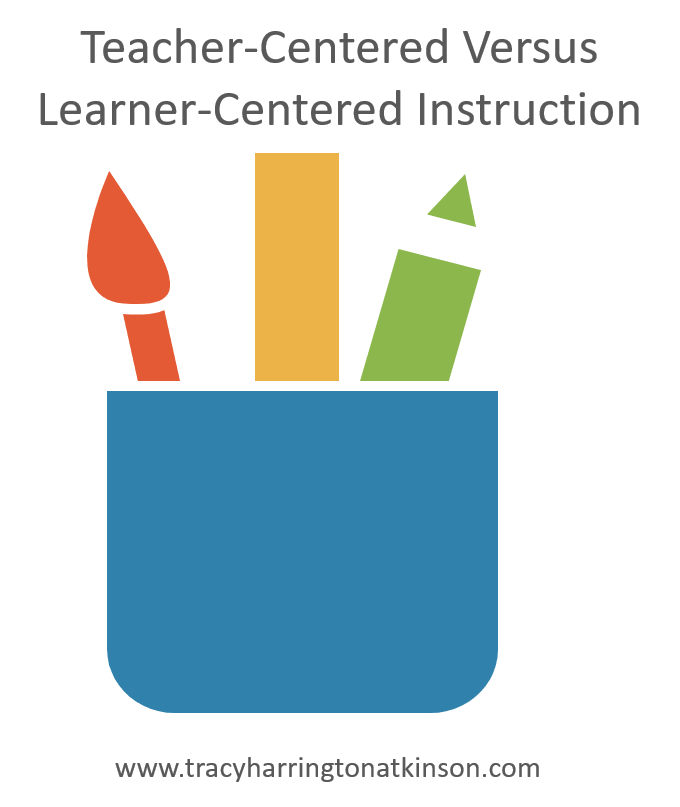
The most effective learning for a student is going to be aligned with their preference for a teacher-centered versus learner-centered instruction. This dichotomy addresses the options of choices of topics, learning methodologies, centralized instruction versus decentralized instruction, desire or interest in topics, motivation, flexibility and more.
Recall that even if a student does prefer a more learner-centered option for instruction, this does NOT negate the role of a teacher, mentor or guide through the learning process.

A teacher-centered approach has the following attributes:
- Focus on the instructor
- Focus on language forms and structures
- Instructor talks; student listens
- Students work alone
- Teacher monitors and corrects every student utterance
- Instructor answers students’ questions about language
- Instructor chooses topics
- Instructor evaluates student learning
- Classroom is quiet

A learner-centered approach has the following attributes:
- Focus is on both students and instructor
- Focus is on language use in typical situations
- Instructor models; students interact with instructor and one another
- Students work in pairs, in groups, or alone depending on the purpose of the activity
- Students talk without constant instructor monitoring; instructor provides feedback/correction when questions arise
- Students answer each other’s questions, using instructor as an information resource
- Students have some choice of topics
- Students evaluate their own learning; instructor also evaluates
- Classroom is often noisy and busy
(National Capital Language Resource Center)
How do you know if a student needs more teacher-centered instruction or learner-centered instruction?
The student will provide verbal cues. Ask your student what they think about the lesson. What did they like or not like about the lesson? Be sure to use open-ended questions to promote discussion and to be able to gather more information.
If your student prefers a teacher-centered approach they will say things like:
- The teacher never taught anything.
- I never heard a lecture.
- The instructor never showed up.
- The teacher wasn’t prepared.
- The teacher couldn’t even give the answers.
- The instructor didn’t know what they were talking about.
- None of my questions were answered straightforwardly.
Any of these answers will indicate that the student was frustrated by the presentation of the content. It simply indicates that the student was given too much autonomy and needed more direction in their learning.
If your student prefers a more learner-centered approach, their responses to these questions will be:
- There was too much lecture.
- I didn’t have time to think or figure it out myself.
- I was discouraged to look for viewpoints of others.
- I didn’t get to look for other information.
- The teacher felt that they had all of the answers.
Any answer that resembles these responses will indicate that the student prefers a more independent or learner-centered approach.
As an educator it is extremely difficult to meet the needs of students who polarize to either side of these options. The best approach is going to be a multi-faceted approach and to be honest with your students. It would be completely appropriate for an instructor to simply state to students who are disgruntled with one approach or another, that there will be opportunities to learn more independently in the next section or lesson, etc.
It is also important to aid students in learning and accepting both modes of instruction as they will encounter both a teacher-centered approach and a learner-centered approach throughout their lifetimes.
Sources:
Candy, P. (1991). Self-Direction for Lifelong Learning. Jossey-Bass: San Francisco. Available: https://amzn.to/3lPVbcg
National Capital Language Resource Center. (2021). Teacher vs. Learner-Centered Instruction. Retrieved from http://www.fullerton.edu/nrcal/seminars/february_2015/documents/day2/nrcal_-_feb_pd_-_teacher_vs_student-centered_instruction.pdf
Subscribe to our YouTube Channel by clicking here.
By Tracy Atkinson
Tracy Atkinson, mother of six, lives in the Southwest with her husband and spirited long-haired miniature dachshunds. She is a teacher, having taught elementary school to higher education, holding degrees in elementary education and an EDS in higher education. Her passion is researching, studying and investigating the attributes related to self-directed learners and learning styles. She has published several titles, including MBTI Learning Styles: A Practical Approach, The Art of Learning Journals, Calais: The Annals of the Hidden, Lemosa: The Annals of the Hidden, Book Two, Rachel’s 8 and Securing Your Tent. She is currently working on a non-fiction text exploring the attributes of self-directed learners: The Five Characteristics of Self-directed Learners.

Comments are closed